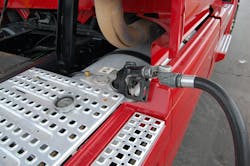Average U.S. retail pump prices for diesel fuel declined this week – with the national average dropping under the $4-per-gallon mark for the first time in several weeks – while gasoline prices continued to inch upwards, according to data tracked by the Energy Information Administration (EIA).
Diesel dropped 1.5 cents this week to $3.988 per gallon, which is 1.8 cents per gallon lower compared to the same week in 2013, the agency reported.
Prices for diesel dropped in every region of the country, EIA noted, falling the most in the Central Atlantic (down 3.7 cents to $4.277 per gallon) followed by New England (down 3.4 cents to $4.279, which is also the most expensive price for diesel in the U.S. this week) and the East Coast as a whole (down 2.3 cents to $4.115).
California ($4.081 per gallon) and the West Coast ($4.009 per gallon, which drops to $3.925 when California’s prices are excluded) rounded out the regions where diesel remains above the $4-per-gallon mark, according to the agency’s data. The Gulf Coast remained home to the cheapest diesel in the U.S. at $3.80 per gallon.
By contrast, EIA said gasoline prices inched up 2/10ths of a penny to $3.549 per gallon this week, though that’s 13.1 cents per gallon cheaper compared to the same week in 2013.
Gasoline prices increased in six regions while declining in three, the agency added, with gasoline the costliest along the West Coast, where it jumped up 1.3 cents to $3.823 per gallon, though that shifts to a 1.2 cent increase to $3.569 per gallon with California’s prices removed from the mix. The biggest one-week hike in gasoline occurred in the Gulf Coast – 3.6 cents per gallon – though that region still remains home to the cheapest gasoline in the country at $3.319 per gallon.
In other energy news, the EIA determined that by September of last year, China's net imports of petroleum and other liquids exceeded those of the U.S. on a monthly basis – making China the largest net importer of crude oil and other liquids in the world.
The rise in China's net imports of petroleum and other liquids is driven by steady economic growth, with rapidly rising Chinese petroleum demand outpacing production growth, the agency said.
U.S. total annual petroleum and other liquids production is expected to rise 31% between 2011 and 2014 to 13.3 million barrels per day, primarily from tight oil plays. In the meantime, Chinese production will increase at a much lower rate (5% over between 2011 and 2014) and is forecast to be only a third of U.S. production in 2014, according to EIA’s data.
On the demand side, China's liquid fuels use is expected to reach more than 11 million barrels per day in 2014, while U.S. demand hovers close to 18.9 million barrels per day, well below the peak U.S. consumption level of 20.8 million barrels per day in 2005. U.S. refined petroleum product exports increased by more than 173% between 2005 and 2013, lowering total net U.S. imports of petroleum and other liquids, the agency stressed.
China has been diversifying the sources of its crude oil imports in recent years as a result of robust oil demand growth and recent geopolitical uncertainties, EIA added, with Saudi Arabia continuing to be its largest crude oil supplier, providing 19% of China's 5.6 million barrels per day in 2013.
Because production levels from Iran, Libya, and Sudan and South Sudan dropped since 2011, China replaced the lost shares of crude oil and other liquids imports from these countries with imports from Oman, Iraq, the United Arab Emirates, Angola, Venezuela, and Russia, the agency said.
About the Author
Sean Kilcarr
Editor in Chief
Sean Kilcarr is a former longtime FleetOwner senior editor who wrote for the publication from 2000 to 2018. He served as editor-in-chief from 2017 to 2018.
